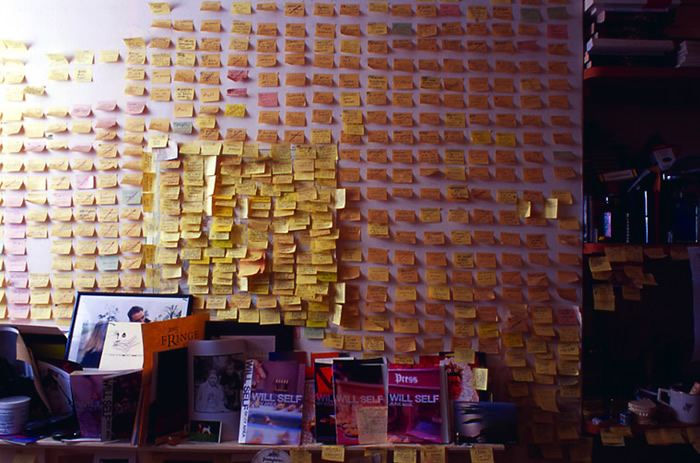I do feel some commitment to public service and as one in four people reading this will be obese, while the other three are merely “overweight”, now seems the right time to do some. Service, I mean – because we’ve all been serving ourselves too much over what’s called the “festive” season and January is the time to take stock . . . not make it. In furtherance of your resolutions, I’m dedicating this week’s column to really disgusting meals. Yes, you heard me right: meals of a true revoltingness such as to turn the stomach of the most hardened gourmand – so sit back and . . . retch.
For my part, it’s difficult to say what the most disgusting meal I’ve ever eaten was. The first one that occurs to me was a wintry repast in every sense. Brixton, January 1983: a frozen young Self picks his way gingerly over bare floorboards to the kitchen. This being a late-20th-century squat, there is no fridge, nor, given that its inhabitants are all on the dole, is there any milk to put in it.
There is, however, a box of cornflakes and another, smaller box with a white and powdery substance in it, so the shivering younger me concocts a bowl of cereal out of these ingredients, simply adding water, and pads back to his revolting fart-sack of a sleeping bag, which is coiled atop a pile of malodorous mattresses. An hour or so later, one of his rather handier housemates, intent on toshing the gaff up, comes looking for the Polyfilla.
By way of an explanation for younger readers: powdered milk was a fairly common phenomenon back in the day, being portion for portion a lot cheaper than the liquid variety, as well as (something I made clear above) not requiring refrigeration. As to why I was able to consume an entire bowl of industrial-strength mastic without noticing, well, what do you think I was getting up to in a Brixton squat in 1983? Flipping out – that’s what, not flipping fucking eggs. I was constipated for a month, which was something of a blessing, as it cut my food bills significantly.
Or maybe the most disgusting meal was the one I had (or rather, began to have) in Delhi in 2000. I’d flown in that evening to cover an arms fair for a programme I was making for the BBC, exposing HMG’s involvement in the international death-metal trade, or IDMT. (Cast your mind back . . . waaay back, to a time of yore, when a mythical, red-bearded, gnome-like foreign secretary spoke of an “ethical foreign policy”.) We were met at the airport by Auntie’s local fixer, a jolly Tamil with one of those implausibly long strings of consonants for a name, who drove us and our abbreviations straight to the old city for dinner.
I remember, perfectly vividly, standing for a moment before we entered the establishment and looking around at the bewildering scene: on the far side of the road, the ancient mud-brick flanks of the Red Fort rose from a hugger-mugger of chai stalls, around which cycle rickshaws and tuk-tuks jockeyed for functionally useless position. Everywhere my eyes alighted, there were people, people, and more hungry-looking people – hundreds, nay, thousands of them, all with the glazed eyes and listless expression of the famished. Once inside, our fixer ordered a slew of dishes, which duly arrived, bish-bosh-bash! The aluminium karahis slammed down on the table so hard that even the flies, stoned on ghee, struggled stickily into the air. The food looked appetising and smelled incredible. I lifted a forkload of steaming chicken curry to my lips and, as it touched them, I actually felt (do I kid you? No) the entamoebae histolyticae leaping into my mouth. I set my fork down and ate no more.
Pointlessly, because, as I knew fine well, it was already too late. I spent the best part of the next few days attempting to interview senior Indian politicians and military officers with my buttocks as tightly clenched as Mike Tyson’s right fist. Strictly speaking, the meal wasn’t “disgusting” – at least not superficially – but once I realised that it was a sort of resort hotel for intestinal parasites . . . the insight affected not only this chicken curry, but all the others I’ve eaten in my life, which were retrospectively rendered . . . utterly disgusting.
Some people shudder at the thought of jellied eels, or blanch if an oyster approaches. Not I. Moreover, if you find yourself eating too many disgusting meals, the problem undoubtedly lies with you, who should simply shut your mouth, rise from the table and walk away. Just as hunger is the finest flavouring (think how much those listless multitudes in the lee of the Red Fort would have enjoyed my curry), so it also seems to exist in a strange symbiosis with greed. Guzzle too much – it doesn’t matter what on – and sooner or later you’ll reach the “Pringles point”, at which the entire world crumbles into a salty mush seething with additives and your gorge rises – and keeps on rising.
Anyway, let me leave you there, with your gorge suspended in disbelief. Keep it up! It’s great exercise and by the time February’s wan fingers caress your sallow chops, you’ll be match-fit again for a year’s worth of greasy takeaways, pullulating curries and the odd bowl of Polyfilla.
